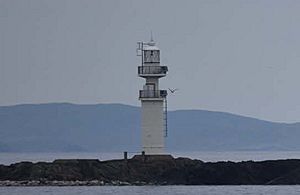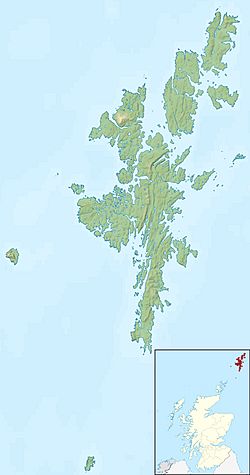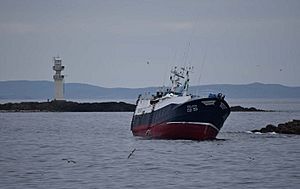Ve Skerries facts for kids
The Ve Skerries or Vee Skerries are a group of small, rocky islands located about 3 miles (4.8 km) northwest of Papa Stour. They are found on the west coast of Shetland, Scotland. These islands mark the southwestern edge of a larger area called St Magnus Bay.
Contents
The Rocky Islands
The Ve Skerries are made up of several individual rocky islands. These include:
- North Skerry
- Ormal (which means "remnant" or "fragment")
- The Clubb (a name that comes from an old word for a "crag" or "rugged hill-top")
- Reaverack
- Helligoblo
Ve Skerries Lighthouse: A Guiding Light
 |
|
|
|
|
| Location | Ve Skerries Papa Stour Shetland Scotland United Kingdom |
|---|---|
| Coordinates | 60°22′23″N 1°48′44″W / 60.3731°N 1.8123°W |
| Year first constructed | 1979 |
| Automated | 1979 |
| Construction | concrete tower |
| Tower shape | cylindrical tower with double balcony and lantern |
| Markings / pattern | white tower and lantern |
| Height | 14.6 metres (48 ft) |
| Focal height | 17 metres (56 ft) |
| Range | 11 miles (18 km) |
| Characteristic | Fl (2) W20s. |
| Admiralty number | A3847 |
| NGA number | 3556 |
| ARLHS number | SCO-253 |
A modern lighthouse stands on the west side of Ormal. It was built after a ship called the Elinor Viking was lost nearby. Before the lighthouse, a lighted buoy was placed here after another ship, the Ben Doran, sank. The lighthouse was also needed because more ships were coming to the area due to the new Sullom Voe oil terminal.
Engineer R. J. MacKay designed the lighthouse, which first lit up on September 27, 1979. The tower is held firmly in place by 18 steel bars. These bars are secured deep into the rock below. The lighthouse was built to withstand very strong forces from the sea.
Building it only took four months, thanks to the help of helicopters. Without helicopters, it might have taken years! In 2020, the lighthouse was suggested to become a Category B listed building, which means it's an important historic structure.
The lighthouse is not open to visitors. Its location is very exposed, making it hard for boats to land there safely.
Shipwrecks: A Dangerous Coast
The waters around the Ve Skerries are shallow and have unpredictable currents. This makes them very dangerous for ships. Many vessels have been wrecked on these rocks over the years.
| Vessel | From | Type | Date wrecked | Casualties | Ref |
|---|---|---|---|---|---|
| Unknown | Whaler | 1602 | |||
| Unknown | 1725 | ||||
| Unknown | 1748 | ||||
| Unknown | c. 1762 | ||||
| True Blue | Brig | ≤ 1850 | Full crew killed | ||
| Turquoise | Cutter | 2 October 1872 | Full crew killed | ||
| Unknown | Barque | 30 October 1880 | |||
| Unknown | September 1883 | ||||
| Nor | Barque | 3 January 1892 | Full crew of 8 killed | ||
| Unknown | Barque | 1892 | |||
| Illeri | Brig | 9 May 1909 | 0 | ||
| Ben Doran | Steam trawler | 29 March 1930 | Full crew of ~9 killed | ||
| Elinor Viking | Diesel trawler | 9 December 1977 | 0 | ||
| Coelleira | Fishing vessel | 4 August 2019 | 0 |
The Illeri Wreck (1909)
The Norwegian ship Illeri was traveling from the Faroe Islands to Leith in Scotland. Early on May 9, 1909, it ran aground on the Ve Skerries. This happened because of thick fog and poor visibility. The crew managed to get into a small boat and safely reached a whaling station at Olnafirth.
News of the wreck quickly reached Lerwick. A steamship called Pole Star went to the Ve Skerries and found the Illeri abandoned and full of water. The ship looked like it had been left in a hurry. The crew of the Pole Star even found the ship's lights still burning and a clock still ticking! They collected important papers from the ship. The Illeri's crew were later sent back home to Norway.
The Ben Doran Tragedy (1930)

On March 29, 1930, the fishing trawler Ben Doran from Aberdeen hit the rocks of Heligoblo during a bad storm. The area was not well mapped, and the tides were very tricky, even for experienced local fishermen.
Another trawler quickly reported the accident. Rescue efforts began, with a large steam trawler called Arora heading out. However, the weather was terrible, with high winds and huge waves. Five of the Ben Doran's crew were seen clinging to the ship's ropes as waves crashed over them.
A smaller motorboat, Smiling Morn, also joined the rescue. Its skipper, John Jamieson, was determined to save the crew, even though it was very dangerous. The conditions were so bad that a small rowing boat being towed by Smiling Morn sank. Despite everyone's brave efforts, the rescue was impossible. The Ben Doran was stuck in the middle of the shallow, rocky area, and no rescue vessel could get close enough.
Sadly, all nine crew members of the Ben Doran were lost. This tragic event showed how much Shetland needed its own lifeboat station. In 1933, the Aith Lifeboat Station was opened, which has saved many lives since. Today, the wreck of the Ben Doran is a popular spot for divers.
The Elinor Viking Rescue (1977)
On December 9, 1977, the trawler Elinor Viking from Aberdeen was wrecked on Reaverack during extreme weather. The Aith Lifeboat was sent, but it couldn't get close enough. The ship's life rafts had been washed away, and the vessel was filling with water.
An urgent call went out for a helicopter from Sumburgh Airport. A volunteer crew, including pilot Captain George Bain and winchman Major Alasdair Campbell, quickly flew to the scene. They arrived in about an hour. Another helicopter and an RAF Nimrod aircraft tried to provide light in the dark, stormy conditions.
The rescue was incredibly difficult. Campbell was lowered to the ship, but his cable got caught in the mast. The pilot, Bain, had to keep the helicopter perfectly steady using a rock that kept disappearing under the waves. Over the next hour and twenty minutes, Campbell was lowered about twelve times, hoisting up the crew one by one. The last person to leave was the skipper, who was so cold or shocked that Campbell had to hit him to make him let go of the railing.
Even though the helicopter crew wasn't specifically trained for sea rescues, all 8 crew members of the Elinor Viking were saved! Both Captain Bain and Major Campbell received Queen's Gallantry Medals for their amazing bravery and skill in such terrible conditions.
The Coelleira Grounding (2019)
Late on August 3, 2019, the fishing vessel Coelleira was heading back to Scrabster with about 15 tonnes of fish. The weather was good, with clear visibility and calm seas. The ship's mate set a course to stay close to the coast to save time.
At 10:30 PM, the skipper took over watch. Over the next two hours, he adjusted the ship's course several times to follow the coastline. He was also busy with paperwork. It's not known how often he checked the ship's exact position.
At 12:23 AM on August 4, the skipper set a course to stay about 3.5 miles (5.6 km) away from any dangers. He didn't see any hazards on his map display. He saw a lighthouse light, but he thought it was on the mainland.
At some point, the skipper left the wheelhouse. While he was returning at 1:24 AM, the Coelleira ran aground on The Clubb, traveling at 10 knots (18.5 km/h). The crew woke up from the crash and quickly put on their survival suits and life jackets. They launched two lifeboats.
At 1:29 AM, the Shetland Coastguard was told about the accident. The Aith lifeboat and a rescue helicopter were sent. All 15 crew members were lifted to safety by the helicopter and returned to Lerwick unharmed.
Later attempts were made to pull the ship off the rocks, but they failed. The ship tilted dangerously, and with bad weather expected, it was decided that the ship could not be saved. In the days that followed, the Coelleira broke apart and sank.
An investigation found that the trip was not planned well, the ship's position wasn't tracked, and the bridge was empty when the ship hit the rocks. It was also suggested that the skipper might have been tired, and the controls on the bridge might have made it hard to see dangers.
Folklore: The Selkies of Ve Skerries
Long ago, people in Shetland told stories about the Ve Skerries. They said these islands were a special place for "Haaf-fish" – also known as selkies. Selkies were magical creatures that looked like seals in the water but could take off their skins and become human on land. They would often gather on the Ve Skerries.
In the past, people would hunt seals on these islands for their skins. According to the tales, sometimes they would accidentally hunt selkies.
One famous story tells of a seal hunter who was left behind on the Ve Skerries when a sudden storm hit. His friends had to leave him because the weather was getting too bad. Then, several selkies came ashore, took off their skins, and began to help their fellow selkies who had been hurt by the hunters. Those who had lost their skins were very sad, as they couldn't return to the sea. One selkie, named Ollavitinus, was especially upset because he couldn't go back to his wives.
Ollavitinus's mother, Gioga, saw the stranded hunter. She offered to take him back to Papa Stour if he promised to return her son's skin. The hunter agreed. As the storm worsened, the hunter worried he couldn't hold onto Gioga's seal skin all the way. He asked if he could cut holes in her skin to hold onto, and she agreed. Gioga safely carried him back to Papa Stour. The hunter then found Ollavitinus's skin in a special hut and returned it, allowing Ollavitinus to go back to the sea and his family.




